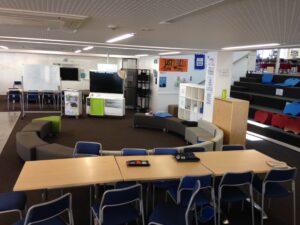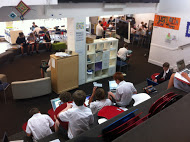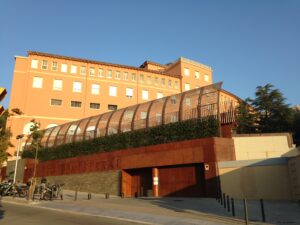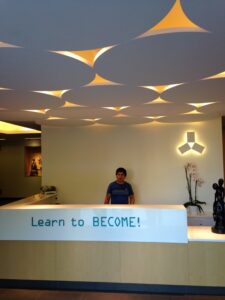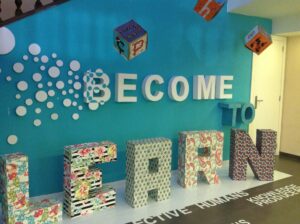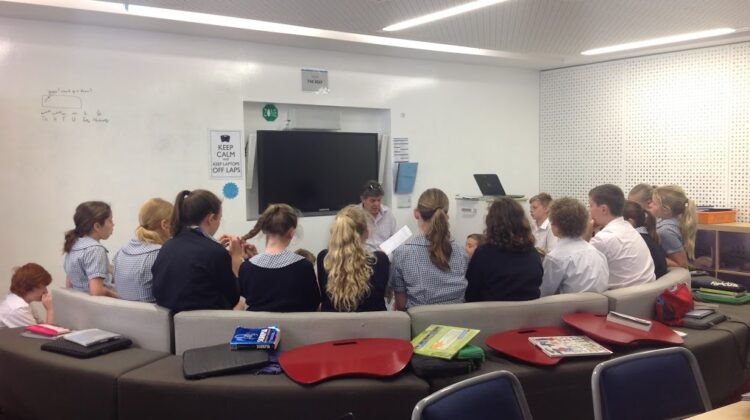

NBCS Sydney
Focusing on learning rather than teaching, changes almost everything we know about a school set up and organization but it is not an easy change.
By Mie Guldbaek Broens, LOOP.bz
I work with observing, studying and developing educational environments that are changing from a system where predominantly teaching is taking place, to an organisation revolving around learning. There are many elements that come together in order to keep this shift on track. One of the elements that we have identified as crucial in making a learning environment work and thus an important element for the shift to work, is the acoustics. When creating an organisation that focuses on learning, it is a part of the pedagogic thinking that not everyone has to do the same activity at the same time or solve assignments in the same way. People working in learning environments will, therefore, often experience that a lot of different activities take place at the same time. It is paramount for learning environments to work and that this is doable and thus good acoustics becomes even more important than it used to be when education was people doing the same task when in the same space.
It varies a lot how disruptive bad acoustics are for the schools’ development, at one of the schools we have been studying ( NBCS in Sydney) both physical and organizational changes have been made in order to accommodate a successful learning environment, and even if the acoustic environment isn’t perfect they have found a level that allows them to continue their development.
NBCS, Sydney
At another school which we are working with ( Col.legi Montserrat in Barcelona) they have reached a point where the physical surroundings are setting the boundary for the further development. The first thing we are addressing is the acoustics, so we can establish a physical setting where the pedagogy can unfold through a process that allows exploring and experimenting.
Col.leg Monserrat, Barcelona
Acoustics in learning landscapes are developing together with the development of the educational environments. It is inadequate to use experiences from open offices, child care services and so on, since a setting filled with kids and staff that are working and concentrating all at once is so different from any other situation we know. There are various techniques you can use to reduce the mental disturbances caused by noise, but many of them are difficult to implement in everyday life in a school. If, for example, you feel that you have some control over the noise or if you feel that you have the possibility of controlling the interruptions you are exposed to during the day, it can affect the performance positively. People who are able to anticipate disruptions can implement preventative tactics to address or minimize the disruption and frustration when disruptions occur, but as you can imagine much of the noise and interruptions in a school nobody can predict or be the master of. Small children and special needs students find it particularly difficult to predict interruptions and it can be extremely challenging for them to control their own level of noise.
We are constantly creating studies in order to learn more about the acoustic benefit in different learning settings and one of the very beneficial studies we have been working with is at a special needs school ( Søgårdsskolen in Copenhagen). While we were observing three classes at the school, there were often several activities going on at once in a class. Sometimes many activities occurred at once because the class was finished with the academic activities and had a little break before they needed to do organized activities again. In those cases, students were often allowed to choose what they wanted to do as long as it didn’t bother the others in the class, as all activities took place in the same room. It does not necessarily mean that kids stick to their own activity, they can easily have their own thing going on, while participating in what the others are doing. The learning environment here is challenging to accommodate acoustically because of the many activities that take place at once, however, it is easier to study as there are fewer people in smaller rooms than in most learning landscapes.
Søgårdsskolen, Copenhagen
So far we have learned a lot from our studies in the different environments and we continue to develop studies in other various circumstances to learn more about what it takes for the physical setting to support different pedagogical environments. One thing that has become more and more clear over the last year, is that you cannot treat the room separately from the activities and the people that are to use it. For instance, there is a big difference in how to treat a room that is to be used for group work and one that is to be used for lectures, but when we want a room to mainly be used for group work but also instructions, we have to teach the teachers how to gather the children for the introductions, if they are to spare their voice. Making a learning environment work is a complicated task that can’t just be fixed with good acoustics, but definitely not without it. All over the world there are schools trying, most of them stumbling along as this new area is being explored and developed.
Quick overview of learning today: Why focus on learning, not teaching – YouTube

